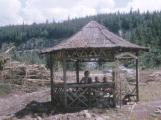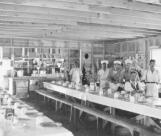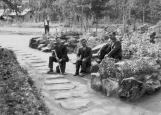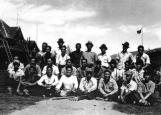1
After the bombing of Pearl Harbour during World War II, hostility increased towards those of Japanese ancestry living in Canada. At mounting pressure from the public, the government declared the West Coast a protected area in which Japanese nationals (those with Japanese citizenship) could no longer live. Soon it decided to send the male nationals to make the Yellowhead-Blue River highway between Jasper and Blue River. Men were separated from their families and shipped via rail to internment camps.The first group arrived at Lucerne on February 22, 1942. The camps were not yet constructed, for the Japanese had to build them and the men had to sleep in railroad cars. Seventeen camps were eventually assembled along the proposed highway. Some camps consisted of log cabins, others only of canvas tents. The men also built Japanese bathhouses, baseball diamonds, vegetable gardens and rock gardens, striving to create beauty and familiarity amidst hostility and sorrow. All the work was done by hand, from clearing trees to smoothing road grade. Each man was paid 25¢ per hour, but had to pay 75¢ per day for board and, if married, send $20 per month to dependents.
Despite their efforts to create a homey environment, however, the Japanese continually faced hostility. CN worried about sabotage to their rail lines, and wanted the Japanese camps moved farther from the railway. The residents of Jasper were concerned for their own safety and afraid that Jasper would become known as the 'Jap town' and tourists would visit rival Banff instead. As a result, only five Japanese men were allowed into Jasper at a time.
2
Kiyokichi Iwamoto - Head Gardener at Tete Jaune Japanese Camp1942-1943
Tete Jaune Cache, British Columbia, Canada
 Credits:
Credits:Susan Izumi
3
Kiyokichi Iwamoto: Head Gardener at Tete Jaune CampIn 1942, at the age of 57, Kiyokichi Iwamoto was evacuated from Vancouver to the road camp at Tete Jaune Cache. There, he helped build the camp, worked on road construction and was the head gardener responsible for growing vegetables to feed the camp internees. In his spare time, he built a beautiful Japanese garden and Japanese tea garden.
While at the camp, he wrote several letters to his daughters (living in Alberta and Ontario) about the incredible beauty of the wilderness in which he found himself. In one letter, he describes his joy (after days of searching) in finding the perfect curved pieces of wood for the bridge he was building in the Japanese garden.
(Written by grand-daughter Susan Izumi)
5
Lyn Charlton, son Randy and daughter Merina at the tea house in the Tete Jaune Japanese camp1960s
Tete Jaune Cache, British Columbia, Canada
 Credits:
Credits:Merina Cochrane
6
Building a bunkhouse at Lempriere1942
Lempriere, British Columbia, Canada
 Credits:
Credits:Shizue Saito, daughter of Masahori Hayakawa
7
Building a bunkhouse at Lempriere:Top row - T Sumi, K Aoyama, T Takashimo, and Masanori Hayakawa. Bottom row - Y Yakura, Y Nagami, T Mura, Y Murata and Yoshi Murata. Hayakawa was sent to Lempriere on March 11, 1942. He and his family, the Hayakawas, were sent to Tashme on September 10, 1942.
8
Mess Hall at Albreda Japanese CampAlbreda, British Columbia, Canada
 Credits:
Credits:Japanese Canadian National Museum and Archives Society
9
Bunk CarsThe Japanese internees were initially put up in bunk cars before they built their accommodation themselves. The bunk cars were used in many camps. There was a kitchen and dining car. The engineers, carpenters and officials had their own cars. Each bunk car housed ten men. It had a small table, long windows, chairs and a washbasin. Coal oil lamps provided light and a wood stove kept them warm. The beds consisted of five upper and five lower berths, complete with spring and mattresses. It is in the cars that the men spent most of their time when they were not working. The men worked six days a week from eight until five with time off for lunch.
10
Japanese foreman Mr. Kawashire with internee Kinzie Tanaka1942
Tete Jaune Cache, British Columbia, Canada
 Credits:
Credits:Kinzie Tanaka
11
Kinzie TanakaKinzie Tanaka worked on this highway project from March 1942 to April 1943. He was among the camp residents whose stories were chronicled in the "The N.C." (The New Canadian). This publication became the most important medium for members of the Japanese community wherever they were exiled.
In the April 14, 1942 issue of the N.C., Tanaka wrote from Lempriere:
"We have a very good group of men; the youngest is 22 years old and the oldest is 67. We have only three men that are over 50 years of age, the rest range around 34 to 44.
Our foreman is quite pleased with the boys in general. Millworkers predominate with a list of 33, gardeners come second with 30, farmers come next with 22. The rest are a heterogeneous group ranging from loggers and shopkeepers to boat builders and fish collectors.
Our washday is Sunday and it certainly is some washday. The fellows have to use hand basins and small tubs to wash in. Some of the more hardy men take their soiled clothes down to the river and wash in the ice cold North Thompson. Some of the fellows tie their clothes to a rope and let the swift current of the river do the work for them.
Now we have built a mile of road from the railway station to the campsite. We have just completed the 100 man messhouse and one bunkhouse. The other buildings are well started also. We have nearly completed a bridge across the North Thompson river about 150 feet long. It is wonderful what the united effort of man can accomplish even without the help of mechanical means. The labour of these men is being recorded in the very earth of Canada and it cannot in future years be said that they have not helped to build up this country.
13
Ball players at an invitational game at Lucerne on July 4, 1942. Teams from Yellowhead, Red Pass, Moose River and Rainbow came to Lucerne.George Funamoto, who was interned at Fitzwilliam and Red Pass, recalls that the Japanese were quite taken with baseball. The Canadian Japanese ball team 'Asahis' (morning sun) of Vancouver were immensely popular.
14
The Project EndsOn 27 July 1942, the Edmonton Journal reported on the termination of work on the Yellowhead-Blue River Highway. By November 1942, all but three of the camps were abandoned. Three camps near Blue River with 200 men stayed open, and men remained there until the end of the war - 1946 - when they were either dispersed into Canada or deported to Japan.
At the peak of the Yellowhead-Blue River project, 1400 men were detained. At the end of the project, the Japanese had worked 290,238 man/days. Their achievements during this short time included clearing and grading 18.5 miles of abandoned railway grade, constructing 35 miles of pioneer road, constructing 1.5 miles of standard highway grade, building one 3-span King Truss bridge, two single span King Truss bridges, four permanent stringer bridges and 12 temporary stringer bridges.
Unrest in the Camps
The division of families was the main reason of unrest in the camps. The men missed and worried about their loved ones, but communication was limited, especially as letters were censored. After a series of strikes and conflicts, as well as mounting tension, the government finally allowed married men to return to their families, who had been relocated to interior towns of B.C.

